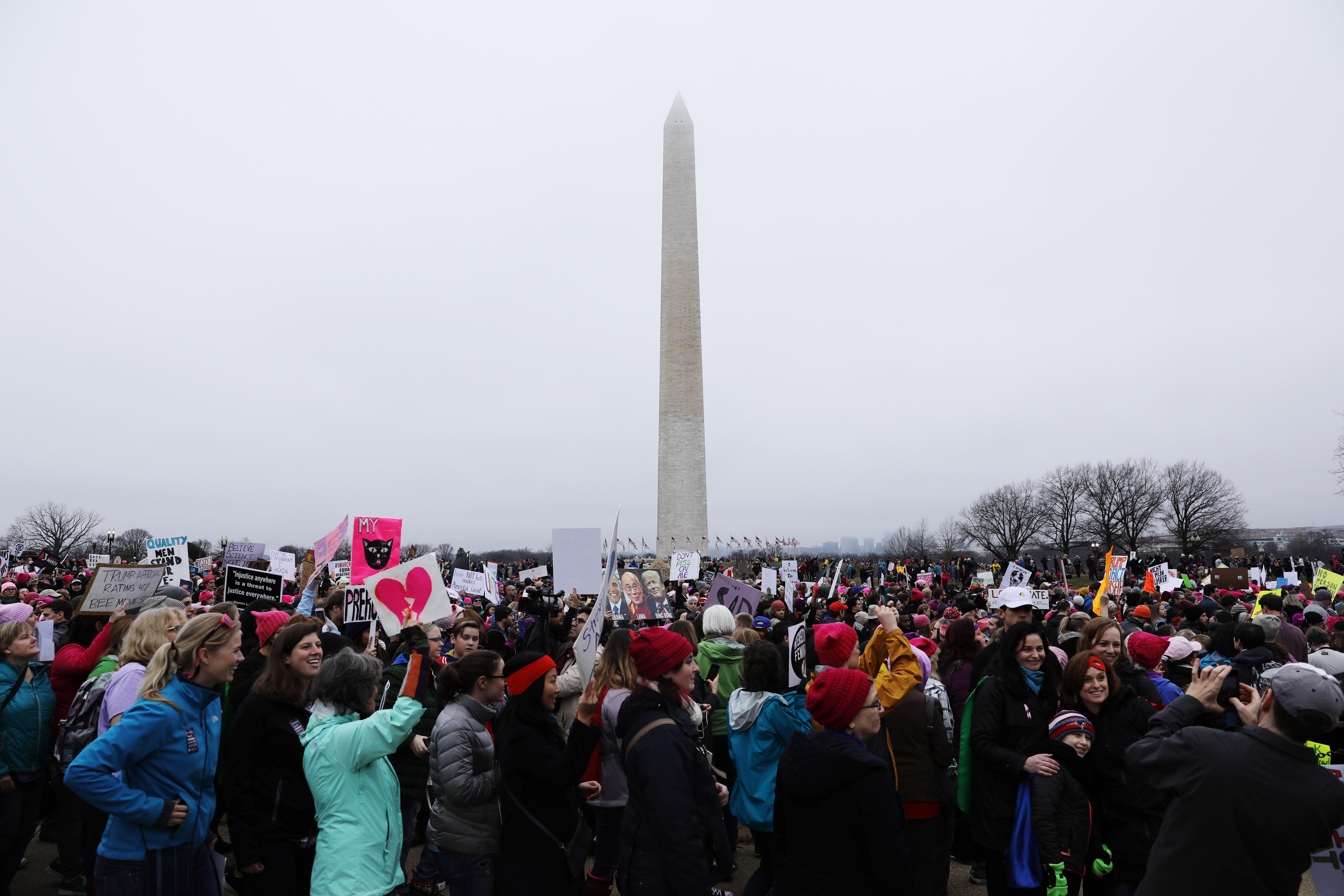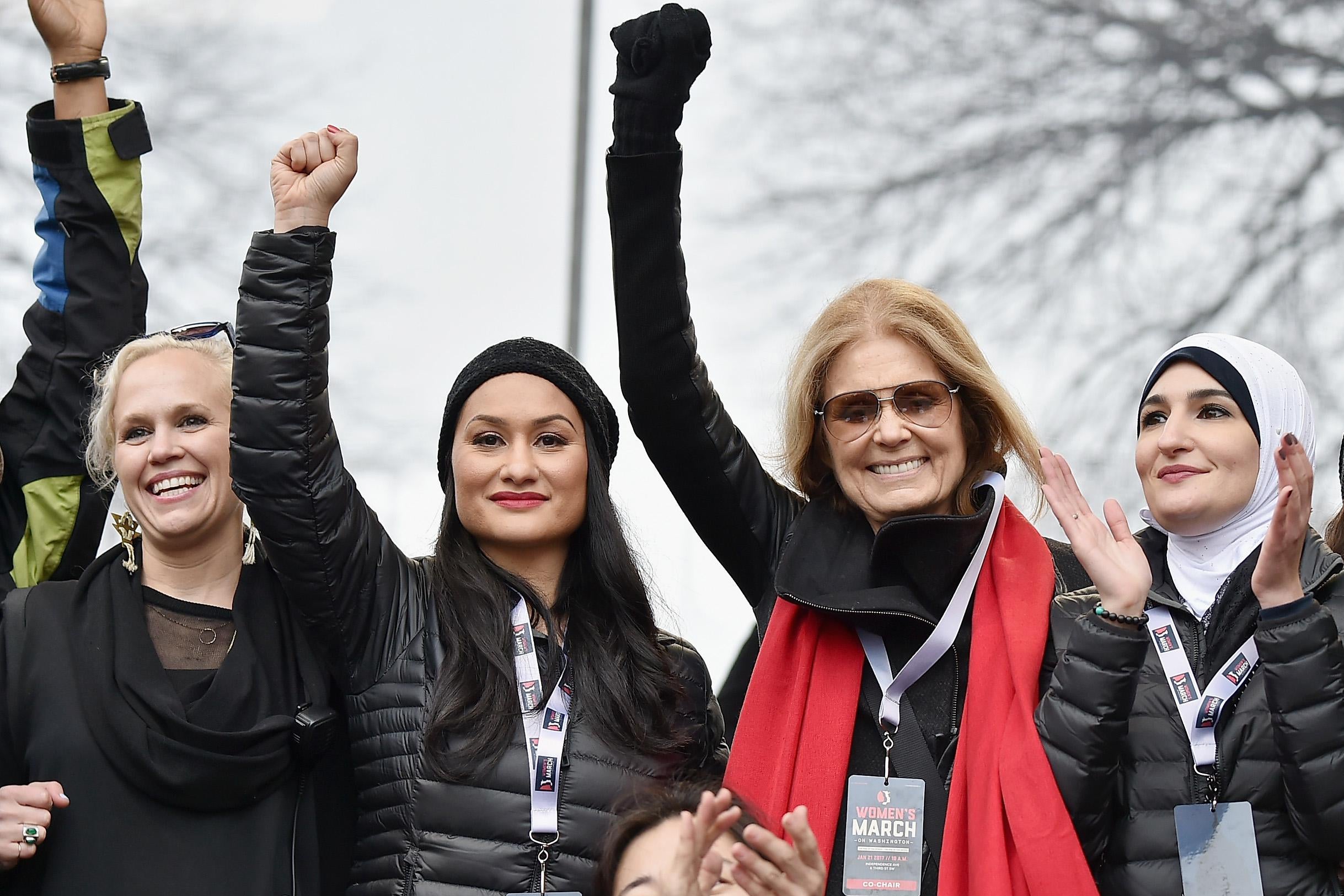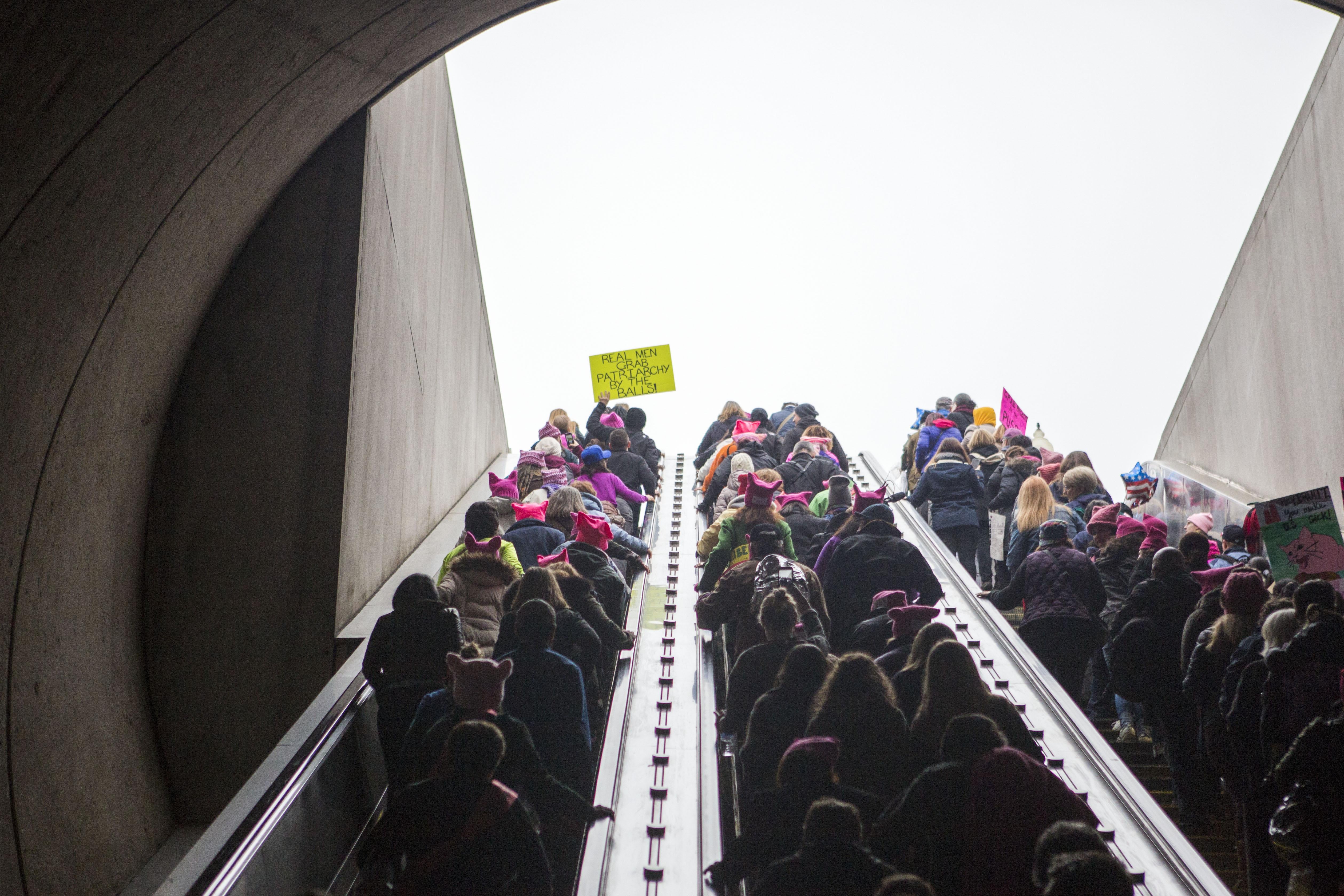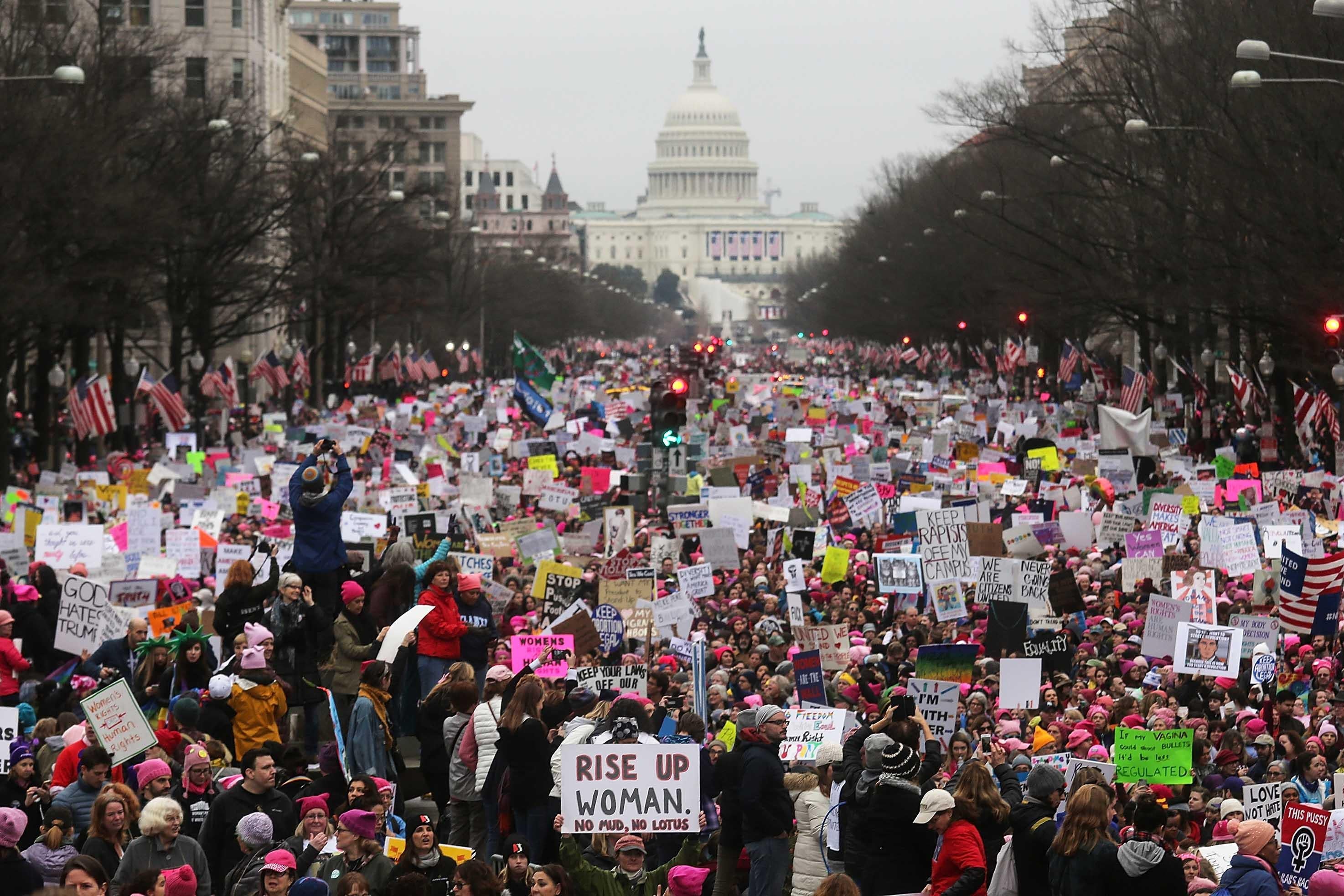The story of the 2017 Women’s March on Washington is so messy, and its unraveling so seemingly a foregone conclusion, it’s easy to miss the miracle that was at its core: What started as a smattering of unconnected Facebook events that sprung up the day after Donald Trump’s inauguration became the largest single-day political action in U.S. history—a convening of nearly half a million people, who organized themselves by state and city and bought plane tickets and chartered buses to D.C. to be together on Jan. 21, 2017, five years ago today.
It is not difficult to imagine how it might have played out differently—and disastrously. Not hard to conjure, for instance, the prospect of a Women’s March that lacked the guidance of the expert organizers who stepped in to right the careening, hastily constructed ship: One hundred thousand people arriving in D.C. with no idea where to go. Desperate women, hemmed in by crowds, taking a leak on the National Mall. A narrow focus on issues that matter most to white women, deepening existing rifts within feminist movements. News coverage focused on the poor planning rather than the message. New activists turned off from public protest for good.
If nothing else, the fact that we remember the Women’s March as a net-positive event rather than a Fyre Festival is a major win.
But five years after the record-setting event, it’s a bit harder to identify its place in contemporary politics. The image of millions of Americans filling the streets to express dissatisfaction with the Trump agenda held immense promise for so many. Did it deliver?

To answer that question, we have to ask a deeper one: What do we expect the purpose of public protest to be? Some critics deem a social movement a failure if it doesn’t yield immediate, tangible policy changes. Barely one week after the 2017 Women’s March, David Brooks was ready to dismiss the demonstration as “mass therapy,” nothing more than a “seductive substitute for action.” Grassroots movements don’t have a great track record, he wrote. “Change happens when people run for office, amass coalitions of interest groups, engage in the messy practice of politics.”
After the Women’s March, participants were quick to put the lie to Brooks’ assumptions. Some did run for office, and some won. The march itself encompassed a diverse coalition of interest groups and the convention that followed, in October 2017, hosted workshops on the messier aspects of political organizing. A Michigan woman I met at that convention told me that her trip to D.C. for the Women’s March inspired her to start an activist group back home. The members of that group threw themselves into the fight against partisan gerrymandering and worked to pass a state ballot initiative for an independent redistricting commission. Now, the Michigan maps have been redrawn. Though it’s impossible to measure how much the Women’s March contributed to that outcome, it unquestionably played a part.
One of the reasons it’s hard to get a full picture of the Women’s March’s impact is that most marchers didn’t limit their Trump-era political activities to events sponsored by the organization. Those who were already involved in issue-based advocacy returned to their abortion-rights groups or their labor organizing or whatever else they’d been doing before Trump’s election. Newcomers to activism joined existing groups or started their own, which functioned as consciousness-raising circles that radicalized their members.
Some marchers went into party politics: One participant from Maine—a woman who’d never done anything political but vote before attending the Women’s March—went home and became the chair of the Maine Democratic Party. Only a fraction of the marchers kept taking their cues from the Women’s March organization itself. And that makes sense: The Women’s March encompassed an almost unbelievably broad array of concerns.
Its expansiveness made it a worthy introduction to progressive activism for people who’d never felt compelled to participate before, but also meant that it could not be a sustainable, long-term driver of policy change.
Even its most enthused participants grasped from the start that the significance of the Women’s March lay in its role as a catalyst for other actions, not as a brand-new leader of the political left.
But the organizers of Women’s March didn’t get that memo. The nonprofit that grew around it treated its four leaders—Tamika Mallory, Carmen Perez, Bob Bland, and Linda Sarsour—as celebrities, the visionary trailblazers at the head of a cohesive political movement.
Organizers of marches are rarely given such disproportionate credit for their events’ success. Seasoned activists know that power of a grassroots movement lies not in its branding or executive leadership structure, but in the people who show up and sustain it. And yet, the Women’s March foursome quickly claimed to speak for something far more decentralized and organic than their own narrative would suggest.
They were everywhere: at fashion shows, cutting in front of rank-and-file participants at events, on magazine covers that they complained were not distributed widely enough. They accepted awards, posed for glamorous photo shoots, and fought a two-year battle to trademark the phrase “women’s march,” which they eventually dropped. Media outlets deserve a portion of blame for being so eager to put a discrete set of faces and names to the story of a colossal new force in progressive politics. (It didn’t hurt that the multi-racial, interreligious leadership team seemed to lend visual credence to the claim that the march had surmounted its rocky white-feminist start.) But the Women’s March organization didn’t do much to refocus all that attention on the thousands of local organizers and millions of marchers who gave the march its meaning.

So when Mallory and Perez drew criticism for their support of noted sexist and anti-Semite Louis Farrakhan, it was no big stretch for critics to use the leaders of the Women’s March to smear the entire movement. For several months, when the women’s groups that had sprung from the 2017 event should have been publicly celebrating the wins of the 2018 midterms, virtually the only media coverage of the Women’s March was about the leaders’ alleged history of anti-Semitic remarks.
Turns out, placing a highly visible hierarchy of self-appointed leaders at the top of a still-fluid grassroots movement is a recipe for defection. Local groups split from the national organization and major partners dropped out. The groundswell of women looking for community and purpose after Trump’s election needed some guidance—literally, marching orders. They did not need a clique of unelected spokespeople.
Luckily, that also meant that when the spokespeople came under scrutiny and stepped out of the spotlight, the people who made up the movement—the vast majority of whom were not particularly or exclusively connected to the official organization—were not derailed.
They had come to the Women’s March not as a unified people following a leader with a specific set of demands, but as individuals with a variety of related grievances, wanting to express a broad feeling of dismay at the direction the country was headed.
Many of them were inspired to undertake a deeper political education and find their place in other movements, including the fight to save the Affordable Care Act and the racial justice uprisings in the summer of 2020. In an alternate timeline, with no Women’s March to warm them up, would many of the white people at those Black Lives Matter marches have shown up at all? Insofar as the coalition that came together in the original march disbanded, it did so not because it was weak, but because it was strong enough to propel its participants far and wide.
But did any of that make a difference? The most memorable subsequent actions of the Women’s March—the groups that traveled to D.C. to beg their senators not to confirm Brett Kavanaugh to the Supreme Court, the marches in the streets to protest the end of Roe v. Wade in Texas—what did they accomplish?
When we consider the utility of public protest in an era of crumbling voting rights, rampant social-media disinformation campaigns, and unlimited corporate election spending, it’s worth taking a long view. Often, demonstrations are judged by their external impact: whether or not a set of demands were met. But in a system of governance that’s built to favor an entrenched minority, populated by legislators who seem increasingly unmoved by public opinion as they pass laws that are interpreted by a partisan, conservative Supreme Court, major policy wins are proving harder to achieve. In all likelihood, the efficacy of today’s progressive movement will not be measured by its immediate victories, but by its endurance.

The purpose of mass protest has always been twofold: There’s the strategic, external part, which seeks to change minds and shift the Overton window. And there’s the spontaneous, internal part, which concerns the experience of the people who are there.
Protests and marches reassure people that they’re neither alone in their anger or fear, nor crazy for being angry and fearful. They introduce demonstrators to new friends and networks of political activity. There’s nothing like the rush of standing in a chanting crowd, sweating or shivering with thousands of people who share one’s outrage, to revive flagging willpower.
As I looked back at videos of the Women’s March this week, I was surprised to be reminded of the good vibes at an event born, for many, of gutting pain. Attendees, many of whom had no doubt spent the previous day grieving Trump’s bone-chilling inauguration, were smiling and laughing, dancing to drums, writing cutesy and corny slogans on signs. By some estimations, this gave the march the appearance of unseriousness, or of unearned triumph for the new would-be activists for whom the hard part had not yet begun. But social movements feed on the sustenance of joy, especially in times when joyful news is hard to come by. In some ways, the Women’s March functioned as a pep rally to pump up participants for the long slog ahead.
The internal benefits of public protest were vital during the Trump administration, and they’re even more relevant now. I’m sure there are plenty of Women’s Marchers who heaved a sigh of relief and went “back to brunch” after Joe Biden took office, thinking the work was done. But I don’t think that’s the prevailing view among the people who first woke up to politics when Trump became president. They watched, as we all did, as right-wing rioters took the Capitol last Jan. 6. They’re witnessing the dissolution of a broad voting rights bill at the hands of two Democratic senators. They’re watching abortion rights disintegrate in Texas and across the South. And they’re living through the hottest years in recorded history, bracing for the next hurricane or forest fire, as the people with the power to save life on Earth as we know it look the other way.
The biggest threat to sustained activism in 2022 isn’t complacency in a political landscape where everything seems great. It’s a feeling of futility, because the political landscape sucks. It’s the sense that political organizing on the left is useless because structural advantages and unfair play are tipping the scales in favor of the right.
In this moment, under those conditions, with five years of hindsight, the Women’s March looks nothing short of revolutionary. It showed hundreds of thousands of people, for the first time, what it felt like to be part of a movement. It gave them the chance to confront each other, face to face, about the lives that are erased when we talk about women as a monolith. It primed its participants to believe in a better future, and to persevere through spates of defeat. Its effects have long outlasted its leaders. Maybe David Brooks was right—that does sound like a “mass therapy” session. And what’s wrong with therapy?
